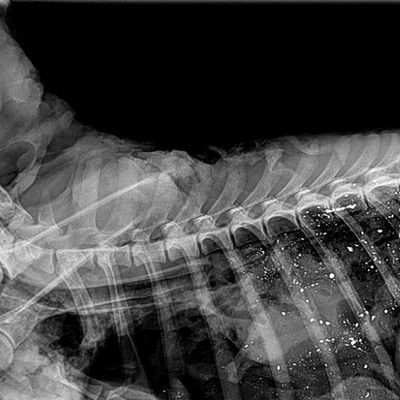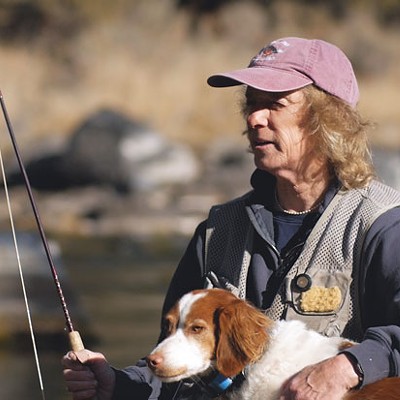Over the Fourth of July weekend, Steve Pribyl was hiking along the lower Deschutes River between Rattlesnake Rapid and Moody when a distressing sight caught his eye. The retired Oregon Department of Fish and Wildlife fisheries biologist and Deschutes River Alliance board member found about 13 dead or distressed sockeye salmon in shallow waters, says DRA Board President Greg McMillan. The apparent cause of death: thermal stress.
Pribyl pushed off in a kayak Tuesday morning to survey the river and look for other fish kills.
With June temperatures reaching highs not normally seen until August, the waters of the Deschutes and other Oregon rivers are heating up, creating dangerous conditions for migratory fish, including an increase in deadly bacteria.
"Normally we see these kinds of conditions later in the summer, not in late June and early July," said ODFW Information and Education Division Administrator Rick Hargrave, in a recent release. "When streams get too warm, fish are stressed and as a result the fishing goes downhill fast." Sockeye salmon in particular, McMillan explains, have a lower tolerance for warm temperatures than other types of salmon, making them the "canary in the coal mine." And in this case, he says, there's a possibility the fish are not just sensitive, but endangered.
"One thing we would certainly like to know is if any of these fish are listed sockeye from Idaho. The timing is right," McMillan says. "If these are endangered that would be huge."
Craig Banner, a senior fish health specialist for the ODFW, says he's not aware of the recent fish kill, but points out they do happen from time to time. He adds that his lab in Corvallis has been analyzing a half-dozen spring Chinook salmon found under the falls near Oregon City, who all appear to have succumbed to a bacteria that thrives in warmer waters. The ODFW lab in Madras did not return a request for comment by press time.
"The bottom line is we've had exceptionally warm waters," Banner says, adding that while early exposure to warmer temperatures can cause fish loss, he isn't aware of any major fish kill events so far this year.
And either way, he figures there's only so much that can be done.
"I don't talk directly to any deity," he explains, "so there's not a whole hell of a lot we can do about it."
But the Deschutes River Alliance is urging Portland General Electric and The Confederated Tribes of Warm Springs, who co-own and operate the Pelton-Round Butte Dam Complex, to release more cool water into the lower Deschutes.
"Last summer, 2014, the dam operators elected to lower discharge temperatures by using more water from the bottom of the reservoir. We think it's time to do that once again," McMillan wrote in a post on the DRA website.
Portland General Electric spokesman Steve Corson says that isn't likely to happen. He confirms that Round Butte operators shifted the balance of water being drawn through its selective water withdrawal tower as an experiment
"Nobody likes to see a situation where you have a fish kill, but we need to be careful not to respond in a manner that responds to the concern of this week but might limit our ability to respond to the needs of the future," he explains. "There's not an infinite supply of cold water at the bottom of the river."
Instead, the dam operators aim for something called "natural thermal potential," essentially a scientific estimate of what the water temperature would have been in the river had the dam not been there.
Currently, Corson says, they are pulling 25 percent of their water from the bottom of the reservoir and 75 percent from the top, resulting in an output of about 59 degrees at the facility. But, he explains, that temperature rises to about 73 degrees at the mouth of river, due to warm, sunny conditions as it passes through the canyon.
"We are learning along the way, and we have made adjustments along the way. But when we do that we need to base that on the best science that's available," Corson says. "It's not something where PGE can say, 'It's really hot, let's lower the water.'"
With temperatures in the canyon approaching or exceeding triple digits, he says that decreases in the water temperatures coming out of the dam would have little impact on temperatures at the mouth of the Deschutes.
Still, Corson notes that outputs are likely to get cooler in the "relatively near future," largely due to cooler days ahead, and the resulting reconfiguration of the natural thermal potential.
"The bottom line for us, we appreciate the frustration of some of the river users who are naturally upset when there are conditions like we're seeing on rivers in Oregon right now," Corson says. "We care about the river and the health of the fish as well."
But DRA's Greg McMillan is not convinced that pulling cooler water at the dam won't impact the mouth of the Deschutes, or that it will hamper the facility's ability to draw colder water later in the summer.
"Last year they did an experiment, pulling 65 percent colder water on July 19 and their cold water supply lasted into September," McMillan says, adding, "That could be seen all the way to the mouth through the temperature gauge at Moody."
In general, McMillan expresses distrust for PGE, explaining that the agency has been less than forthright with information in the past.
"We tried to work with them collaboratively for over two years," he says, "and mostly what we got was stonewalling, foot dragging, and obfuscation."


























